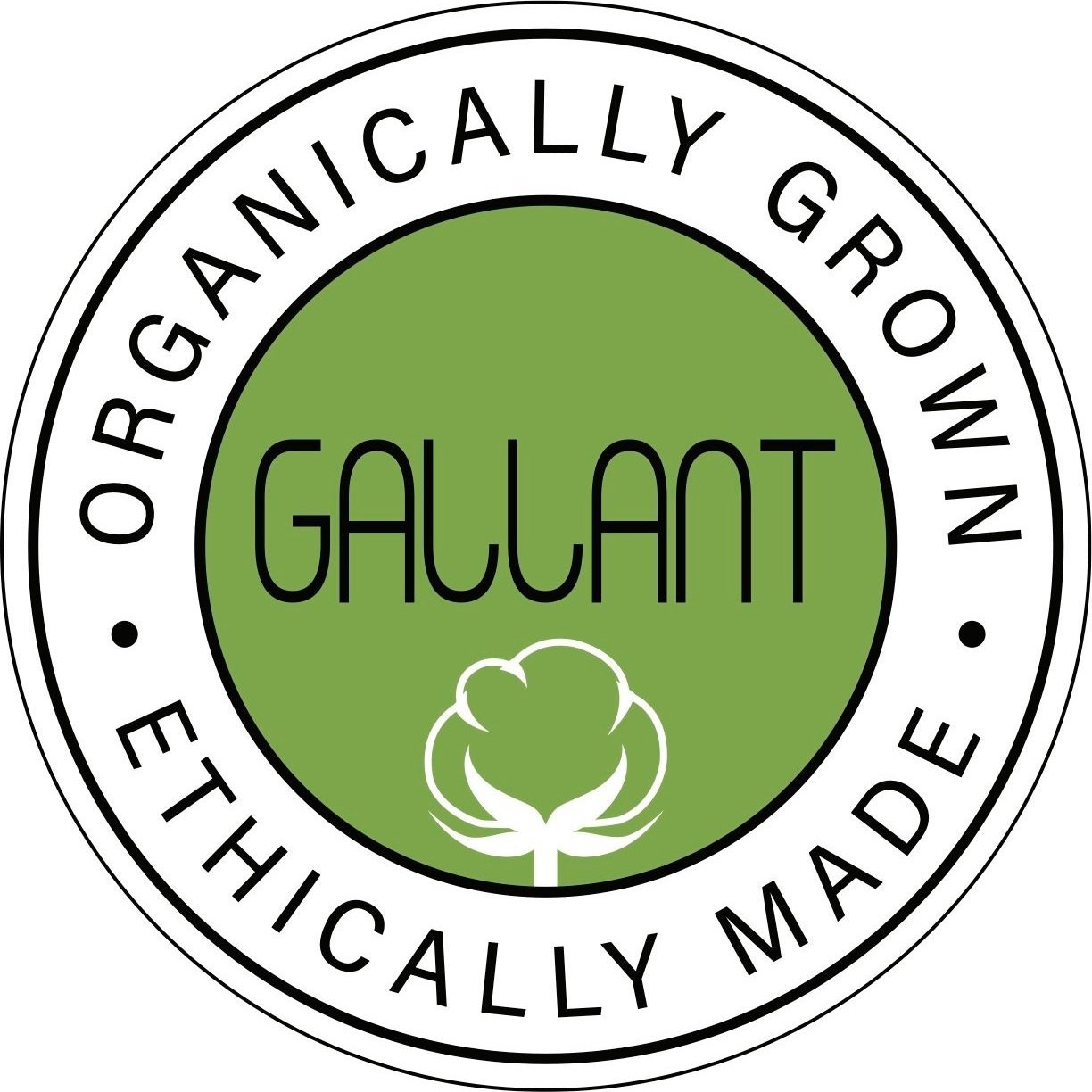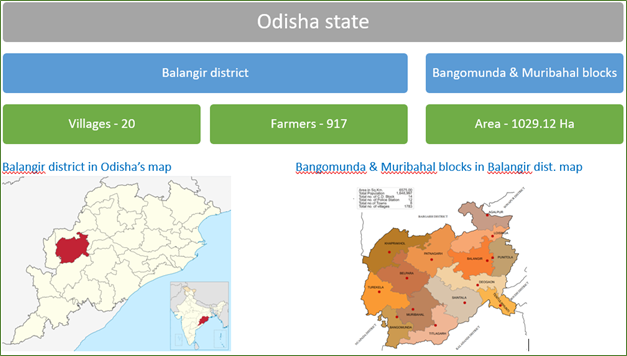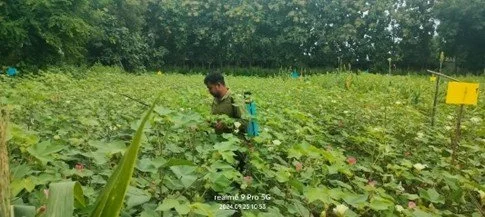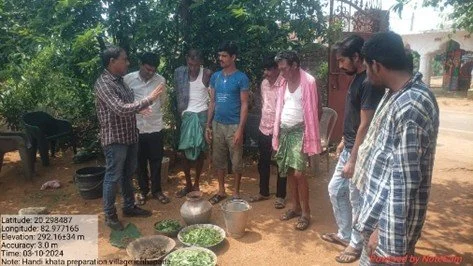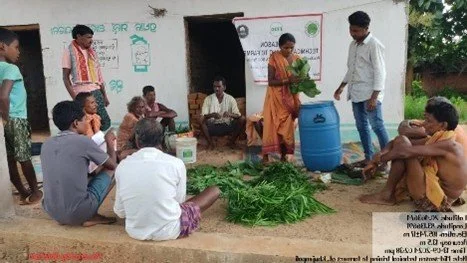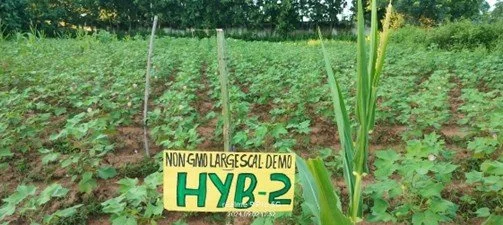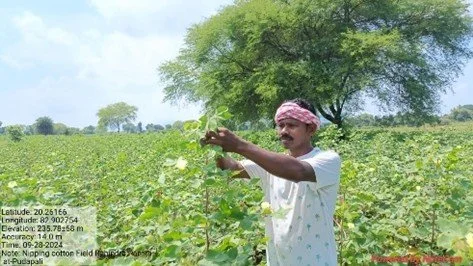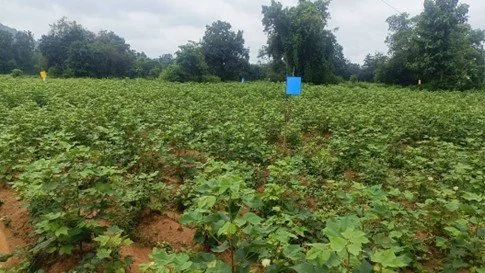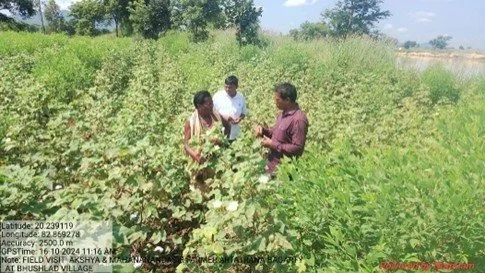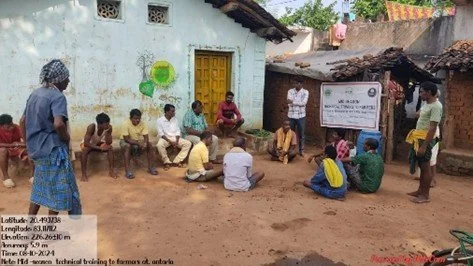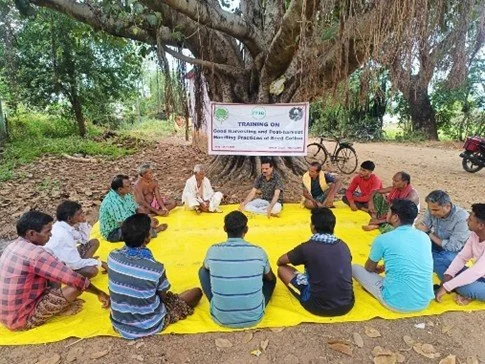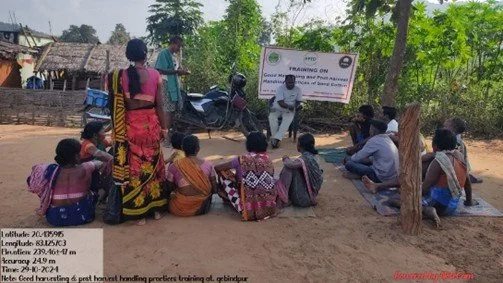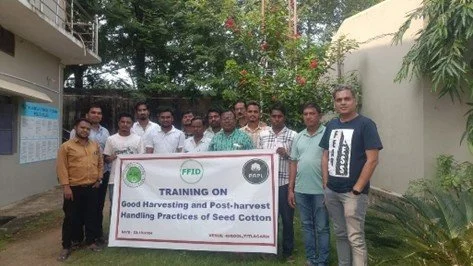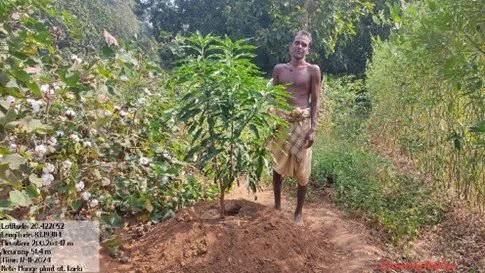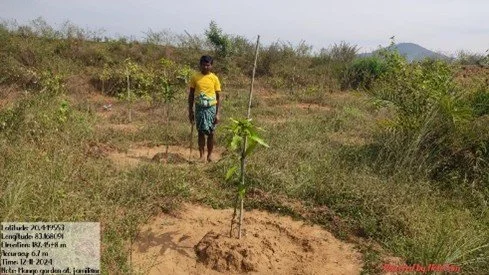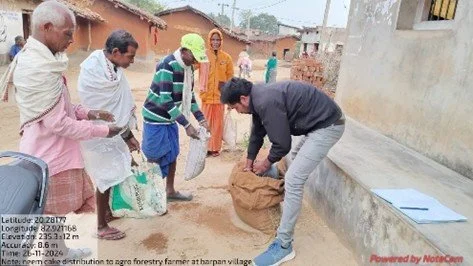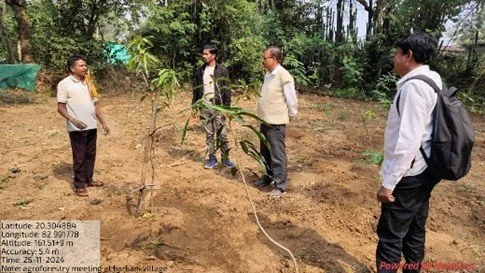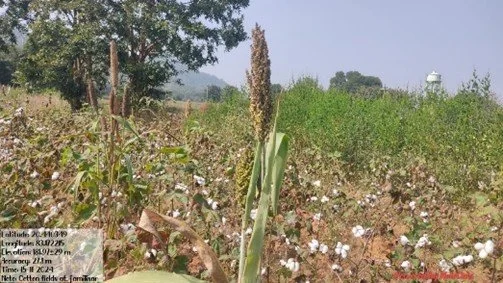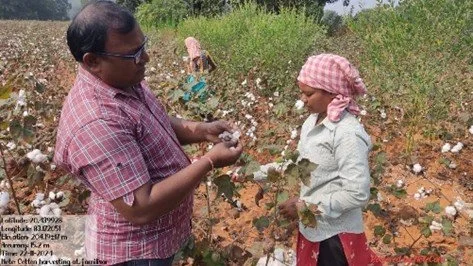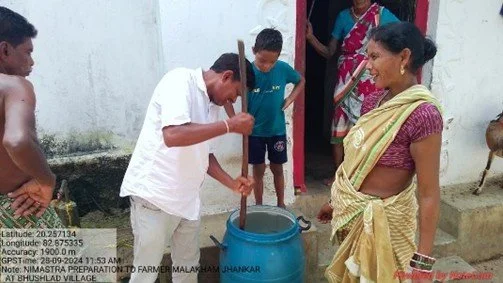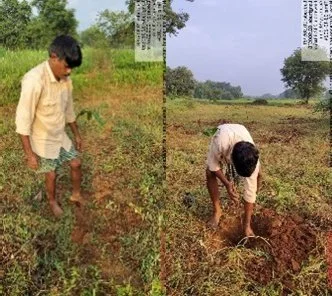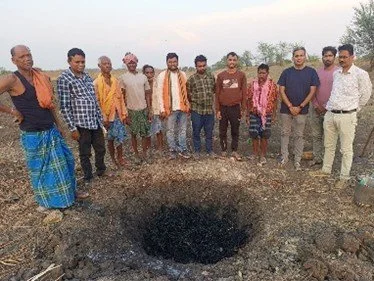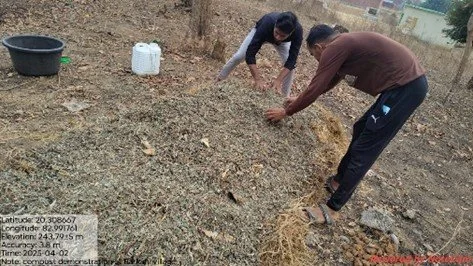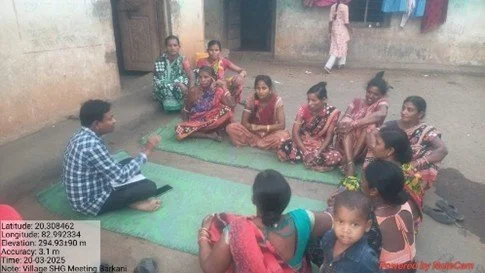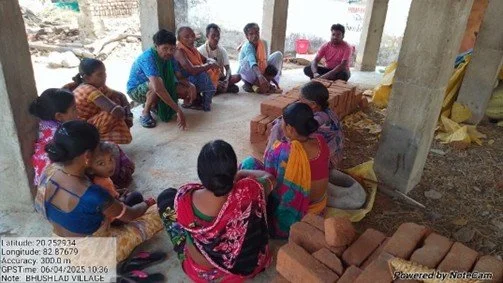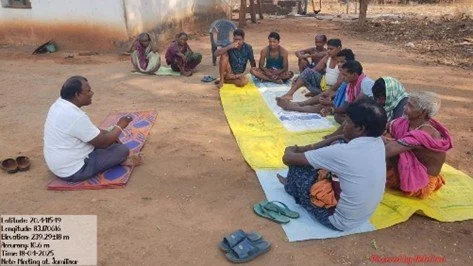A MODEL FOR REGENERATIVE ORGANIC COTTON: ODISHA INITIATIVE Introduction
Our Regenerative Organic Cotton initiative in Odisha, India is committed to transform cotton farming practices for 917 farmers in the Bangomunda and Muribahal blocks of Balangir district—an ecologically sensitive and drought-prone region in the eastern state of Odisha, India that primarily produces long-staple cotton.
Although the region is predominantly agrarian, it faces a range of challenges, including limited or no irrigation, deforestation, desertification, hot and dry summers, erratic rainfall, fluctuating groundwater levels, soil degradation, monoculture, non-remunerative farming, and a lack of subsidiary occupations. These factors contribute to widespread distress migration to nearby peri-urban and urban areas.
This project represents a strategic intervention focused on establishing a robust system of training, extension services, and internal quality control. It seeks to revitalize the local agricultural landscape by employing experienced, committed, and fairly compensated staff. The ultimate goal is to empower resource-poor farmers including women farmers and rural youth, while addressing climate vulnerability through the adoption of regenerative organic practices at both the individual farm and broader habitat levels.
Key stakeholders include local cotton farming communities, a local NGO serving as the implementing partner, and international brands committed to fair trade, regeneration, and sustainability.
ROC PROJECT AREA: BANGOMUNDA & MURIBAHAL BLOCKS (BALANGIR, ODISHA, INDIA)
OBJECTIVES
- Restore soil health and increase soil organic carbon through the adoption of regenerative agricultural practices
- Ensure access to quality inputs by training farmers in the on-farm production of compost, biochar and liquid manure and by supplying high-quality non-GMO seeds, planting materials for intercropping and green manuring, as well as support for vegetative barriers and agroforestry.
- Enhance climate resilience by improving soil health, promoting on-farm rainwater harvesting and introducing diversified income streams through subsidiary occupations and increased on-farm biodiversity.
- Build institutional capacity and farmer leadership through regular village-level and on-farm training sessions, encouraging democratic farmer organizations and active community participation.
- Improve food and nutritional security by enriching soil health and increasing the diversity of crops and farm enterprises.
- Strengthen farmer livelihoods through fair pricing, assured market access, crop and enterprise diversification, support for supply chain development for other crops, and local employment generation.
- Promote environmental conservation through agroforestry, conservation of riparian zones, control of invasive species, creation of pollinator habitats and preservation of natural ecosystems, contributing to long-term environmental sustainability.
- Reduce distress migration by making integrated farming systems (IFS) more remunerative, sustainable, and dignified.
- Ensure traceability, compliance and certification in accordance with NPOP, NOP, Fairtrade and Regenerative Organic Certified® (ROC) standards.
OUR APPROACH
Our holistic model started with comprehensive household-level socio-economic surveys, community-level Participatory Rural Appraisal (PRA) exercises and gap assessments to identify key areas for intervention, both in terms of compliance with organic and regenerative organic standards and in implementing welfare measures. A sufficient number of soil samples are collected and tested to understand soil types, detect any deficiencies, and plan appropriate interventions.
The approach integrates regenerative organic farming techniques with climate-adaptive water management and biodiversity and habitat restoration strategies. Farmers are provided with free non-GMO seeds, support for on-farm input production, and technical training delivered by experienced field staff and managers. Practices such as multi-cropping, minimal tillage, mulching, vegetative cover, nipping, agroforestry, and biochar production are actively promoted.
Given the challenges of rainfed agriculture and erratic rainfall, the model emphasizes the measures viz. construction of farm ponds, strengthening of farm bunds, creation of zigzag drains and implementation of furrow diking to conserve both water and soil.
Regular and rigorous farmer-level training sessions, group meetings, risk assessments and internal monitoring and control systems ensure that our approach delivers sustainable, measurable and continually evolving impact.
COLLABORATORS / PARTNERSHIPS
This initiative is made possible through dynamic collaboration among grassroots implementing organizations, local farming communities, technical experts, and certification bodies. Partnerships with government departments are also being explored to facilitate convergence on farm pond construction and input subsidies. Additionally, the initiative places strong emphasis on on-farm research collaborations to identify high-yielding, non-GMO cotton varieties best suited to the region
EXPECTED OUTCOMES / IMPACT
- Improved soil health, enhanced soil organic matter and organic carbon content, better water retention capacity and increased productivity on smallholder cotton farms, along with reduced soil erosion and improved water conservation.
- Commercial release of improved, high-performing non-GMO cotton genotypes (both hybrids and varieties) to farmers practicing Regenerative Organic Certified® (ROC) cotton cultivation.
- Increased yields due to the use of improved non-GMO cotton genotypes and better water availability through farm pond construction.
- Diversification of income streams through the adoption of subsidiary enterprises such as horticulture, vegetable cultivation, livestock rearing, pisciculture, and beekeeping.
- Reduced input costs and increased farm profitability through on-farm bio-input production, provision of free seeds and planting materials, potential use of non-GMO cotton ‘varieties’ that do not require annual purchase, diversified cropping systems and natural pest and weed control measures. The experience from 2024-25 crop year showed that eliminating chemical external inputs and shifting to on-farm, regenerative practices reduced input costs significantly and improved overall farm profitability.
- Higher household incomes are enabled by fair pricing (including MSP) and premium payments along with the sale of intercrops, and other farm-based outputs. The experience from the 2024–25 crop year showed that an average ROC (Regenerative Organic Certified) farmers in the Odisha project earned 17-19% more than conventional farmers selling their produce at local ginning units and to village middlemen. The extra earnings included both the Minimum Support Price (MSP) and an additional organic price premium. This premium compensates for the extra efforts and compliance required for organic and regenerative standards. Efforts are underway to increase farmers’ average yields from 500 kg to 600 –700 KG per acre in the coming years through the continued adoption of ROC practices, the use of better high-yielding hybrid seeds, increased income from intercrops and improved access to water from efficient rainwater harvesting for critical irrigation and bio char project implementation.
- Improved presence of beneficial insects, diverse pollinators and predatory birds in farmlands, supporting crop health and productivity.
- Development of a replicable and certifiable model for Regenerative Organic Cotton farming in semi-arid regions.Enhanced biodiversity and ecosystem restoration through cultivation of flowering strips, planting of native trees, and promotion of agroforestry practices.
- Empowerment of farmer groups through capacity-building, fair contractual arrangements, and access to dedicated markets.
- Empowerment of women farmers through income-generating activities and organization into self-help groups.
- Reduction in distress migration by making agriculture and allied activities more secure, profitable, and sustainable.
TIMELINE
| Sl No | Intervention / Impact Area | Monitoring Timeline | Expected Measurable Outcomes |
|---|---|---|---|
| 1 | Soil health improvement (organic matter, SOC, water retention, erosion control) | Baseline in year 0; follow-up in Year 3 and Year 6 | Observable increases in SOC (0.2–0.4% per year), better moisture retention, reduction in erosion indicators |
| 2 | Commercial release & adoption of improved non-GMO cotton genotypes | Year 1 for trials; Year 2–3 for wider adoption and tentative commercial release in 3rd or 4th year | Higher germination rates, pest resistance, increased yields (by 10–25%) |
| 3 | Yield improvement (due to improved genotypes + efficient nutrient management + pest control + irrigation) | Year 2–3 onwards | Quantifiable increase in cotton yield per acre, reduced crop loss due to drought stress |
| 4 | Income diversification through allied activities | Year 2–4 | Additional income from horticulture, livestock, pisciculture, etc. contributes 20–30% of total farm income |
| 5 | Household income rise (MSP + premiums + diversified cropping) | Year 2–5 | Measurable increase in net farm income by 30–50% by Year 4–5 |
| 6 | Beneficial insect and bird activity | Year 2 onwards (seasonal monitoring) | Increased sightings or counts of beneficial species (pollinators, predators), improved crop health |
| 8 | Cost reduction via on-farm inputs, free seeds, etc. | Year 1–2 | Reduced dependency on external inputs; 20–40% drop in input costs |
| 9 | Biodiversity and ecosystem restoration | Baseline in year 0; evaluation in year 3 and year 5 | Richer species diversity (plants, pollinators); increased agroforestry coverage |
| 10 | Model development (replicable ROC system) | Initial framework by year 2; validated model by year 5 | Documented protocols, verified outcomes, replicable Package of Practices |
| 11 | Empowerment of farmer groups and SHGs | Capacity building from year 2; empowerment impacts visible by year 3-4 | Functional women's Self-Help Groups, leadership emergence, access to markets and credit |
| 12 | Reduction in distress migration | Household surveys from year 1; clear trends by year 4 | Decrease in seasonal migration, improved livelihood security metrics |
Visuals
EXTENSIVE TRAININGS TO ICS STAFF
DEMONSTRATIONS ON INPUT PREPARATION
FREE OF COST DISTRIBUTION OF NON-GMO COTTON INTERCROP SEEDS
DISTRIBUTION OF SEEDLINGS TO FARMERS UNDER AGROFORESTRY PROJECT
DISTRIBUTION OF DRUMS TO FARMERS FOR ON-FARM INPUT PRODUCTION
DISTRIBUTION OF DRUMS TO FARMERS FOR ON-FARM INPUT PRODUCTION
INTERCROPPING
DEVELEOPMENT OF DEMONSTRATION PLOTS
MID-SEASON TECHNICAL TRAINING TO FARMERS
MID-SEASON TECHNICAL TRAINING TO FARMERS
MID-SEASON TECHNICAL TRAINING TO FARMERS
NON-GMO SEED TRIALS
FARMER PRACTICING NIPPING IN THE COTTON CROP
USE OF STICKY PADS FOR PLANT PROTECTION
ASSESSMENT OF CROP PERFORMANCE AND HEALTH BY ICS STAFF
FIELD TEAM WITH GALLANT’S REPRESENTATIVE
MID-SEASON TECHNICAL TRAINING TO FARMERS
TRAINING ON GOOD HARVESTING & POST-HARVEST HANDLING PRACTICES
TRAINING ON GOOD HARVESTING & POST-HARVEST HANDLING PRACTICES
TRAINING ON GOOD HARVESTING & POST-HARVEST HANDLING PRACTICES
FARMER WITH HORTUCULTURAL CROPS PLANTED UNDER AGROFORESTRY PROGRAM
FARMER WITH HORTUCULTURAL CROPS PLANTED UNDER AGROFORESTRY PROGRAM
DISTRIBUTION OF NEEMCAKES
MONITORING VISIT TO AGROFORESTRY PROGRAM BY ICS AND MANAGERIAL STAFF
INTERCROPPING OF RED GRAM AND SORGHUM WITH COTTON
ON-FARM GUIDANCE BY FIELD STAFF ON RESPONSIBLE HARVESTING PRACTICES
TRAINING ON ON-FARM INPUT PREPARATION
A FARMER PLANTING SAPLINGS UNDER AGROFORESTRY PROGRAM
MR VIK GIRI WITH LOCAL STAKEHOLDERS
DEMONSTRATION OF PIT METHOD OF BIOCHAR MAKING
DEMONSTRATION OF BED COMPOST METHOD
MEETING WITH WOMEN SHG MEMBERS FOR INPUT PRODUCTION
VILLAGE LEVEL FOCUSED GROUP TRAINING CUM AWARENESS SESSIONS
MEETING WITH WOMEN SHG MEMBERS FOR INPUT PRODUCTION
VILLAGE LEVEL FOCUSED GROUP TRAINING CUM AWARENESS SESSIONS
VILLAGE LEVEL MEETINGS FOR PLANNING DEMONSTRATIONS FOR BIOCHAR, BED COMPST AND OTHER ON-FARM INPUTS
